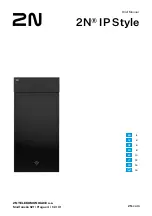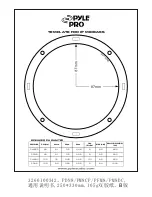
less than half the design volume will curtail bass performance and should be avoided.
Reaching through the rough-in opening and adding a bead of glue or caulking along the
junction of the stud and the wallboard at both sides of the opening, both front and back,
will increase the stiffness of the cavity enclosure near the speaker. This will also provide
insurance against possible buzzing from air movement in the cavity.
Bass response is affected by the shape of the wall cavity, as well as by the size and
resulting volume of the cavity. Sound radiated from the speaker driver inside the cavity
reflects back from the boundaries of the cavity. The strongest effects are resonances at
the frequencies whose wavelengths are multiples of the cavity dimensions, which
emphasize or de-emphasize these specific frequencies—with resulting unevenness in
overall response. Several, straightforward steps will avoid and lessen these negative
effects:
1. Do not locate speakers at the mid-points of wall or ceiling cavities—where the
distance from the speaker driver to both ends of the wall cavity will be the same
and resonance effects will be doubled. One-third and one-quarter points should
also be avoided for the same reason, although the negative effects will be less.
2. Have standard (unfaced) fiberglass insulation loosely fill the wall cavity, (or at
least at both ends of the cavity and at the mid-points between the speaker driver
and the ends in both directions). This insulation allows the sound to travel through
in both directions, but mixes the lengths of travel and absorbs some sound energy
(particularly resonant sound) as heat to lessen any resonant effects. If the wall
cavity is fully insulated, it should be left in place, removing only a portion of the
insulation directly behind the speaker system to avoid physically obstructing the
normal operation of the system or over-damping the sound output. The insulation
also reduces transmission of sound through the cavity rear wall to neighboring
spaces.
WIRING
A. Rough-in Wiring
Typically, a cable with a wire pair connects each speaker to the signal sources, either
directly or through a local volume control. The speakers must be wired appropriately for
the intended control. The impedance loads of speakers must be balanced with the
capabilities of the amplifier(s). In some, mono only systems a single wire may "daisy
chain', entering from one speaker to another—beginning and ending at the amplifier. If
biamplification or biwiring is desired for increased dynamic response and power handling,
a second cable pair of wires must be run to the speaker. Wire size should increase with
longer runs—usually 16 AWG stranded copper wire is minimal, with 12AWG desirable for
longer runs. Additionally, a control wire is required to any IR sensor installed on a speaker
baffle. Audio cable should avoid the electrical power wiring to avoid interference, which
can be audible—never running directly adjacent to it and crossing at right angles, when
necessary. Holes are normally located in the middle one-third of the framing depth to
minimize structural effects. If wire is within 1" of the front face of the framing, it should be
covered with (standard) steel protection plates to prevent later fasteners from piercing the
cable.
Wiring should be run to each back frame and inserted through one of the integral wire
clamps (no other fastener is required). Leave some additional wire at every end, in case
of a later shift; and dress the wire into the wall cavity, away from the opening.
B. Finish Wiring
When you install the baffle-mounted speakers, the ends of each wire need to be
separated, stripped, twisted and inserted into the correct, spring-Ioaded terminal post.
Polarity needs to be maintained—typ/rib/writing/red/right—for uncompromised
performance. The ends of the wires through each terminal post should be pushed over
slightly to avoid any contact with the wire strands through the other terminal post or with
the crossover circuit board. The terminal posts are spaced so that the wires can be
connected, if desired, using standard banana jacks either through the ends or the sides of
the posts.
C. Tricks of the Trades—Drilling
When running wire through wooden framing, drill clean holes slightly larger and aligned
with each other to be able to pull cable through in longer sections with minimal snagging.
Auger style drill bits with threaded tips are self-feeding, can chew through an occasional
nail, and save much strain (although they can become jammed in thick timbers). Right
angle drills help in narrow spots to get holes drilled and to maintain hole alignment. Short
spade bits also get the job done more easily in tight spots between studs.
GRILLES
A. Installing and Removing
Install Grilles by aligning one edge and corner against the Finish Frame and then working
the edges and corners of the Grille into the Finish Frame—avoiding force which can bend
the grill or scratch the edges of the Finish Frame. A putty knife is useful to ease the
process
To ensure that Grilles in ceiling locations will not vibrate loose, small dabs of putty can be
inserted at several locations into the groove between the Finish Frame and the Baffle
before the Grille is inserted and edges embedded. Alternatively, Grille edges can be bent
very slightly inward at several spots on each side to "bite" the baffle wall of the groove
more securely.
Removing a Grille is most easily accomplished without scratching the finish by inserting
an unfolded paper clip or a small brad nail into a perforation and gently pulling forward at
several locations near a corner to start the removal.
B. Grille Alternatives—Scrims, Hole Shapes and Sizes
Grilles must be designed for acoustical transparency and also for visual opaqueness,
weather resistance, and paintability. We use aluminum for weather resistance. The
relatively small perforations in a slightly thicker material improve paintability and strength,
while maintaining acoustical transparency. The removable scrim feature allows the scrim
to be removed during grille painting then re-applied, to avoid fabric contamination. The
slight decrease in high frequency output is accounted for in the crossover design. If the
scrim cannot/is not being used, flip the baffle mounted “HIGH” switch down to optimize
the response.
PAINTING
A. Construction Dust and Paint Shield
The Construction Dust and Paint Shield should be installed when the speaker drivers are
installed, if construction is not yet completed. The shield fits snugly to protect the drivers.
It can be removed after painting and other construction is completed by squeezing the
IV.
8
9
VI.
V.
























